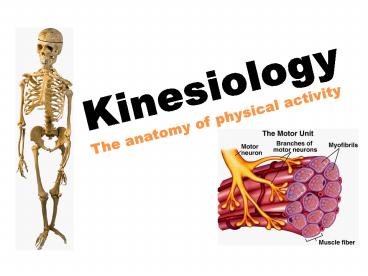Kinesiology The anatomy of physical activity - PowerPoint PPT Presentation
1 / 42
Title:
Kinesiology The anatomy of physical activity
Description:
Kinesiology The anatomy of physical activity #1 A joint is a point of connection between two bones #2 Strands of connective tissue and ligaments hold the bones ... – PowerPoint PPT presentation
Number of Views:283
Avg rating:3.0/5.0
Title: Kinesiology The anatomy of physical activity
1
KinesiologyThe anatomy of physical activity
2
(No Transcript)
3
Anterior
Posterior
4
Superior (Above)
Inferior (Below)
5
Anatomical Planes
or Imaginary flat surfaces that divide the human
body into unique segments
1 divides body for further identification of
particular area 2 allows description of
different movements or actions
6
1 Median or Midsagittal (Lilac) 2 Frontal or
Coronal (Green) 3 Transverse or Horizontal
(Purple)
7
- 1 Flexion
- reduces the angle between two bones at a joint
- 2 Extension
- increases the angle between two bones at a joint
Sagittal Plane
Sagittal Plane
8
- 1 Dorsiflexion
- bringing the top of the foot toward the lower leg
or shin - 2 Plantar flexion
- planting the foot
Sagittal Plane
9
- 1 Abduction
- moving a segment away from the midline of the
body - 2 Adduction
- moving segment toward the midline of the body
Frontal Plane
10
- Rotation
- When a force is not exerted along a line that
passes through a bodys center of gravity
(eccentric force), the body will experience
angular (rotary) motion
Transverse Plane
11
- 1 Pronation (Prone Position)
- when the palm is moved to face posterior
- 2 Supination (Supine position)
- when the palm is moved to face anterior
Transverse Plane
12
Center of Gravity
13
(No Transcript)
14
(No Transcript)
15
Nomenclature and Planes AgainMore examples
16
1. Posterior/Anterior 2. Lateral/Medial 3.
Dorsal and Ventral 4. Superior and Inferior
17
(No Transcript)
18
(No Transcript)
19
(No Transcript)
20
Horizontal Slice
21
Sagittal Slice
22
Coronal Slice
23
The Skeletal SystemWhat is it and how is it
important?
24
rigid internal frameworkarea to attach
musclesproducing movementprotection of
organsprovides red blood cellsminerals (Ca2)
25
- According to the degree of porosity, bone can be
classified into two general categories
- 1. Compact bone
- (low porosity)
- 2. Spongy or cancellous
- bone
- (high porosity)
Bone General Structure
26
- 1. Short - Support
- 2. Long Leverage
- 3. Flat - Protection
- 4. Irregular Multi
Structure-Function Relationship
27
- 1. Short - Support
- 2. Long Leverage
- 3. Flat - Protection
- 4. Irregular Multi
28
- 1. Short - Support
- 2. Long Leverage
- 3. Flat - Protection
- 4. Irregular Multi
29
- 1. Short - Support
- 2. Long Leverage
- 3. Flat - Protection
- 4. Irregular Multi
30
- 1. Short - Support
- 2. Long Leverage
- 3. Flat - Protection
- 4. Irregular Multi
31
The Skeletal SystemAxial and Appendicular
skeleton
32
- Axial Skeleton
- 1 Skull
- 2 Sternum
- 3 Ribs
- 4 Vertebral Column
Skeleton
33
- Appendicular Skeleton
- 1 The pectoral girdle (chest)
- 2 Pelvic girdle (hip)
- 3 The upper limbs
- 4 The lower limbs
Skeleton
34
- 1 A joint is a point of connection between two
bones - 2 Strands of connective tissue and ligaments
hold the bones together and ensure the stability
of joints
35
- Joints can be classified partly on the basis of
the material that joins them - 1. Fibrous joints
- Allow no movement
- E.g., sutures of the skull
- 2. Cartilaginous joints
- Allow limited movement
- E.g., inter-vertebral discs
- 3. Synovial joints
- Allow large range of movements
- E.g., hip joint
36
Synovial Joint The Knee
Synovial Joint
37
Structure-Function Relationship
38
- 1. Ball and Socket Joint
- 2. Condyloid Joint
- 3. Saddle-shaped joint
- 4. Hinge Joint
- 5. Pivot Joint
39
(No Transcript)
40
Common disorders of the skeletal SystemWhy
should we be active?
41
Some Common Skeletal Disorders
- Osteoporosis weakening of bone
- Osteoarthritis degenerative joint disease
- Fracture broken or splinter bone
- Sprain connective tissue issues
- Scoliosis excess sideways curvature of spine
- Kyphosis rounding forward of upper spine
- Spina Bifida involves spinal cord exposure
42
Finally - What about physical activity and bone
integrity?Why should we be active?































